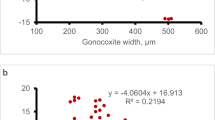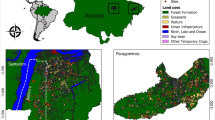Abstract
Different types of adaptations of dragonflies to climatic conditions of the desert zone are described. The main habitats of the dragonfly nymphs are lotic and semi-lotic artificial reservoirs. The life cycles are synchronous with seasonal climatic changes, reproduction being restricted to periods of the optimal hygrothermal conditions. Some species reveal vertical seasonal migrations. The labile daily activity rhythms allow the dragonflies to avoid the effects of unfavorable conditions. Adults of many species emerge at night.
Similar content being viewed by others
References
Belyshev, B.F., Kharitonov, A.Yu., and Borisov, S.N., “Asian Part of the USSR,” in Fauna and Ecology of Dragonflies (Nauka, Novosibirsk, 1989), pp. 11–31 [in Russian].
Bey-Bienko, G.Ya., “Habitat Changes in Terrestrial Organisms as a Biological Principle,” Zh. Obshch. Biol. 27(1), 5–20 (1966).
Borisov, S.M., “Irrigation Systems as Habitats for Dragonfly Nymphs (Insecta, Odonata) in the Valleys of Tajikistan,” Doklady Akad. Nauk TadzhSSR 28(9), 541–543 (1985a).
Borisov, S.M., “The Daily Activity Rhythm of Anax parthenope Selys (Odonata, Aeschnidae)” in the Arid Zone,” Doklady Akad. Nauk TadzhSSR 28(10), 603–606 (1985b).
Borisov, S.M., “Abundance of Some Dragonfly Species in Valleys of Southwestern Tajikistan,” Vestn. Zool., No. 2, 38–42 (1986).
Borisov, S.M., “Ecology of Two Closely Related Dragonfly Species in Tajikistan,” Ekologiya, No. 1, 85–87 (1987).
Borisov, S.M., “The Biotopic Distribution of Dragonfly Nymphs (Insecta, Odonata) in Southwestern Tajikistan,” Doklady Akad. Nauk TadzhSSR 32(3), 206–208 (1989a).
Borisov, S.M., “The Distribution and Ecology of Orthetrum sabina Drury (Odonata, Libellulidae) in Southwestern Tajikistan,” Izv. Akad. Nauk TadzhSSR Biol., No. 2, 17–21 (1989b).
Borisov, S.M., “The Daily Activity Rhythm of Crocothemis servilia Drury (Odonata, Libellulidae) in the Arid Zone of Tajikistan,” Vestn. Zool., No. 1, 42–47 (1990a).
Borisov, S.M., “Dragonflies (Odonata) Attracted by Artificial Light Sources,” Zool. Zh. 69(2), 29–35 (1990b).
Borisov, S.N., “Ethology-Climatic Adaptations of Dragonflies in the Desert,” in Proc. of 15th Intern. Symp. Odonatology. Novosibirsk, July 9–19, 2001 (2001), p. 21.
Chernov, Yu.I., Natural Zonation and Fauna of Land (Mysl, Moscow, 1975) [in Russian].
Chemyshev, V.B., Daily Activity Rhythms in Insects (Mos. State Univ., Moscow, 1984) [in Russian].
Dronzikova, M.V., Candidate’s Dissertation in Biology (Novosibirsk, 2000).
Gorodkov, K.B., “The Three-Dimensional Climatic Model of Potential Distribution Range and Some of Its Properties,” Entomol. Obozr. 65(1), 81–95 (1986).
Jacquemin, G., “Odonata of the Rif, Northern Morocco,” Odonatologica 23(3), 217–237 (1994).
Jödicke, R., “Subspecific Division of Sympetrum sinaiticum Dumont, 1977, and the Identity of S. vulgatum decoloratum (Selys, 1884) (Anisoptera: Libellulidae),” Odonatologica 23(3), 239–253 (1994).
Jödicke, R., “Die Odonatenfauna der Provinz Tarragona (Catalonya, Spanien),” Adv. Odonatol. 1(Suppl.), 77–111 (1996).
Jödicke, R., “Die Binsenjungfern und Winterlibellen Europas: Lestidae,” in Die Neue Brehm-Bucherei. Vol. 631 (Westarp-Wiss., Magdeburg, 1997), Vol. 631, pp. 1–277.
Jödicke, R., Borisov, S.N., et al., “Additions to the Knowledge of Sympetrum sinaiticum Dumont (Odonata: Libellulidae),” Int. J. Odonatol. 3(2), 131–140 (2000).
Jödicke, R. and Mitamura, T., “Contribution towards an Annotated Bibliography on Hibernation in Sympecma Burmeister (Odonata: Lestidae),” Opusc. Zool. Flumin., No. 133, 1–9 (1995).
Ketenchiev, Kh.A. and Kharitonov, A.Yu., Dragonflies of the Mediterranean Basin (El-Fa, Nalchik, 1999) [in Russian].
Kharitonov, A.Yu., “Life Cycles of Some Dragonflies in the Eastern Ural Area,” Izv. Sib. Otdel. Akad. Nauk SSSR, Ser. Biol., No. 5, 55–59 (1977).
Kharitonov, A.Yu., “Latitudinal Changes in the Phenology of Dragonflies (Insecta, Odonata) of the Transural Area and Kazakhstan,” Ekologiya, No. 2, 93–96 (1980).
Kharitonov, A.Yu., Doctoral Dissertation in Biology (Moscow, 1991).
Kharitonov, A.Yu. and Borisov, S.N., “The Phenology of Dragonflies,” in Fauna and Ecology of Dragonflies in the USSR (Nauka, Novosibirsk, 1989a), pp. 67–76 [in Russian].
Kharitonov, A.Yu. and Borisov, S.N., “The Daily Activity Rhythms of Dragonflies,” in Fauna and Ecology of Dragonflies in the USSR (Nauka, Novosibirsk, 1989b), pp. 77–85 [in Russian].
Kumar, A., “The Phenology of Dragonflies in the Dehra Dun Valley, India,” Odonatologica 1(4), 199–207 (1972).
Kumar, A., “On the Occurrence of Multivoltine Generations in Some Indian Dragonflies,” Sci. Cult. 45(3), 126–127 (1979).
Mukhamediev, A.M., Hydrobiology of the Ferghana Valley (FAN, Tashkent, 1967) [in Russian].
Popova, O.N., Candidate’s Dissertation in Biology (Novosibirsk, 1999).
Popova, O.N., “Dependence of the Distribution of Sympetrum Dragonflies on the Properties of Larval Habitats,” Belyshevia 1(1), 14–17 (2001).
Samraoui, B., Bouzid, S., et al., “Postponed Reproductive Maturation in Upland Refuges Maintains Life-Cycle Continuity during the Hot, Dry Season in Algerian Dragonflies (Anisoptera),” Int. J. Odonatology 1(2), 118–135 (1998).
Solbrig, O.T. and Solbrig, D.J., Introduction to the Population Biology and Evolution (Addison-Wesley, Reading, 1979; Mir, Moscow, 1982) [in Russian].
Stepanova, N.A. and Ledyaeva, A.I., “A Contribution to the Hydrobiology of Rice Fields, Irrigation and Discharge Canals in Andijan Province, Uzbek SSR,” Trudy Inst. Zool. Parazitol. Akad. Nauk UzbekSSR 9, 103–152 (1957).
Ueda, T., “Sexual Maturation, Body Color Changes and Increase of Body Weight in a Summer Diapause Population of the Damselfly Lestes sponsa (Hansemann) (Zygoptera: Lestidae),” Odonatologica 18(1), 75–87 (1989).
Author information
Authors and Affiliations
Additional information
Original Russian Text © S.N. Borisov, 2006, published in Zoologicheskii Zhurnal, 2006, Vol. 85, No. 7, pp. 820–829.
Rights and permissions
About this article
Cite this article
Borisov, S.N. Adaptations of dragonflies (Odonata) under desert conditions. Entmol. Rev. 86, 534–543 (2006). https://doi.org/10.1134/S0013873806050058
Received:
Issue Date:
DOI: https://doi.org/10.1134/S0013873806050058




